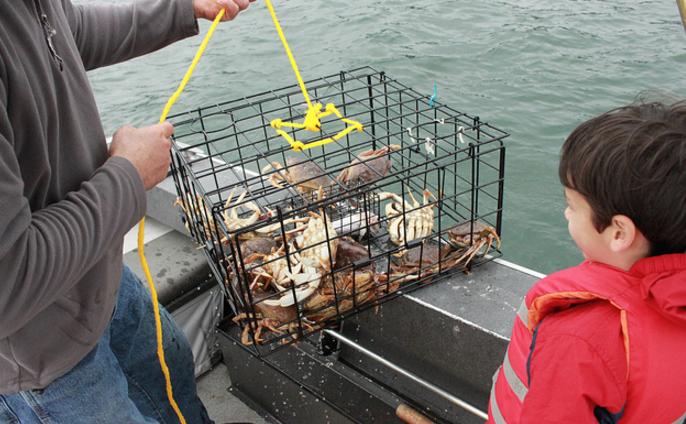Crabbers in Maryland and Virginia face new harvest restrictions, a move that managers in both states have said is necessary because of the Chesapeake Bay’s low population of juvenile crustaceans.
Maryland’s Department of Natural Resources (DNR) announced Tuesday that the commercial crab season will close Nov. 20, ten days earlier than it did last year. The state’s crabbers also face a cutback in the number of adult female crabs they can harvest. Those who fish 300 pots will be able to keep five bushels of females, as opposed to nine last year; those with a 600-pot license can keep 10, as opposed to 13 last year; and those with a 900-pot license can keep 15, as opposed to 30 last year.
The Virginia Marine Resources Commission (VMRC) voted Tuesday to close its crabbing season Nov. 30 — twenty days earlier than last year. Virginia also instituted reduced bushel limits for its license holders for all of November. It will open its 2018 spring season March 17, instead of March 1 this year.
VMRC board chairman John M.R. Bull called the commission’s decision “prudent management of this species” and said the crabbers recognized they were taking a necessary step. “Crab management issues are always difficult, but we’ve seen tremendous improvements in the species over the past seven or eight years,” he said. “We have the largest number of adult female crabs. We have to protect the juveniles, though. This year’s babies are next year’s mamas.”
The harvest cuts come after the latest winter dredge survey results, released in April, showed that the highest number of female crabs in the 28-year history of the annual count. The tally for females was 254 million, a 31 percent increase over last year.
But the Baywide survey, which counts the crabs in more than 1,000 locations as they burrow in the mud, showed a marked decrease in young crabs. It estimated that there were 125 million juveniles in the Chesapeake — a 54 percent decrease from the 271 million found in 2016. That is the lowest tally since 2013 (a year when crabbers also had their catch curtailed) and one of the five lowest estimates since 1990, managers said.
Catches of the Chesapeake’s most valuable seafood are being curtailed later in the year in an effort to protect the smaller population of juvenile crabs as they reach market size, so that they will be around to reproduce next year.
Maryland DNR’s Blue Crab Industry Advisory Committee and Tidal Fisheries Advisory Commission approved the cuts in votes this week, DNR officials said. The DNR’s announcement came a day after the Chesapeake Bay Stock Assessment Committee, made up of federal and state fisheries officials, warned both states to take a “cautious, risk-averse approach” to managing blue crabs.
Billy Rice, chairman of the DNR Tidal Fisheries Advisory Commission and a Southern Maryland crabber, said the department was doing just that with this decision.
“We’re taking a conservative approach. We’re not going whole hog. We tried to make the changes as liberal as possible, but we felt there had had to be a response,” he said. Other options included a shorter season and less of a bushel cut; Rice said it’s better for the population and the markets to have a longer season with a higher bushel limit.
By law, the Virginia commission must annually consider reopening that state’s winter dredge fishery for crabs, which would allow crabbers to take pregnant females that spend the cold months burrowed in the mud. The dredge fishery in Virginia closed a decade ago, a move researchers have credited with helping the Bay’s crab population recover from a crisis in 2008. This year, Bull said, no one asked for the fishery to be reopened.
Not every crab scientist approves of how management has reacted to the year-over-year changes in the notoriously boom-and-bust blue crab species. Tom Miller, a crab specialist who directs the Chesapeake Biological Laboratory at the University of Maryland Center for Environmental Science, said it’s hard to evaluate the population’s long-term stability and the harvest it can withstand if management reacts seasonally. Crabs live between one and three years and can reproduce furiously, or not much at all. After being spawned near the mouth of the Bay, their offspring hitch a ride on ocean currents back into the Chesapeake. Some years, many return; some years, many don’t.
“I am not convinced that we need to change management,” Miller told the Bay Journal in May. “One of my concerns has been that managers have been too responsive to individual winter dredge survey results. The reference points are meant to be long-term responses of the crab population under constant conditions — and as a result, frequent changes to the management regime makes evaluation of this problematical.”
No Maryland DNR fisheries managers were available to answer questions about the state’s new harvest limits, a department spokesman said.
In the past, the DNR’s longtime blue crab manager, Brenda Davis, would have explained changes in management to both the public and crabbers But Davis, a 28-year employee, lost her job in February after several Dorchester County watermen held a private meeting with Gov. Larry Hogan Jr. and his deputy chief of staff, Jeannie Haddaway-Riccio, an Eastern Shore native who is close to many watermen.
They accused Davis of not being flexible enough about rules on the legal size of crabs. Those rules have not been changed, though a small group of crabbers continue to push for it.
“When you fire your expert,” Billy Rice said, “it’s pretty tough [to provide information].”
By Rona Kobell
Bay Journal staff writer Rona Kobell is a former reporter for the Baltimore Sun.



Write a Letter to the Editor on this Article
We encourage readers to offer their point of view on this article by submitting the following form. Editing is sometimes necessary and is done at the discretion of the editorial staff.